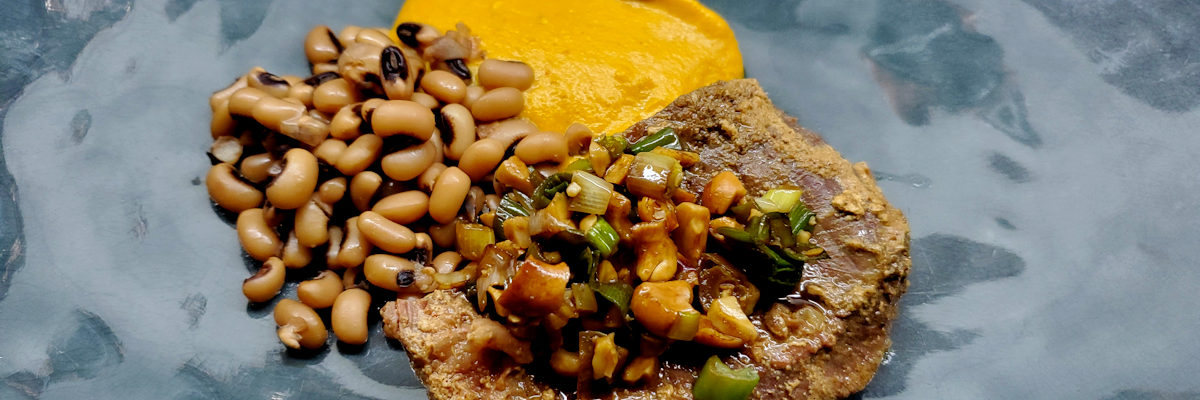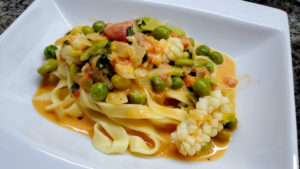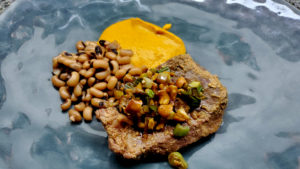October 4-5, 2019
Favorite Plates
Penne a la vodka. It was all the rage back in the day. Now, we can sort of easily surmise that it isn’t a traditional Italian dish – I mean, the very thought of a vodka, tomato, and cream sauce just doesn’t fit the genre. And while it isn’t a traditional dish, it was, more or less, invented in Italy. The story goes something like… back in the early to mid-1970s, there was a big push from distillers and importers and distributors on in Europe and the U.S. to get people to drink vodka. It resulted in numerous really bad cocktails. In Italy, where cocktail culture was not the biggest thing around, the distributors got creative, and challenged Italian chefs to create dishes using vodka in lieu of other wines and spirits.
In 1974, Italian actor Ugo Tognazzi published a cookbook (why do so many actors think they’re qualified to be chefs…? Then again… these days, why do so many chefs think they’re qualified to be actors…?) in which he included a recipe for pasta all’infuriata, or furious pasta. He described it as a re-take on an arrabbiata sauce, using Polish vodka and chilies. Tognazzi, if you’re not into classic Italian films, where he was practically ubiquitous, would most likely be remembered for his role as the gay night club owner in the original 1978 French version of La Cage aux Folles, or for those of you who are sci-fi and/or cult film buffs, as Mark Hand, the Catchman, in the 1968 film Barbarella.
From there, it’s unclear – there’s a split between those who give credit for the creamy version we know as penne a la vodka to a chef at Dante restaurant in Bologna, and others give it to one James Doty, in New York (who seems to always be annotated as “a graduate of Columbia University” – so perhaps he “invented” this while student?). Either way, it became all the rage on into the mid-80s, when it more or less faded away. Italians, after all, are not overly forgiving when people start modernizing, changing, or introducing dishes in Italian cuisine.
It had a bit of a resurgence that’s still sort of lingering, triggered by an Italian chef in Russia, Valentino Bontempi, who brought it back for World Pasta Day and presented it as a representative dish of Italy – something that probably caused a whole lot of consternation amongst Italians everywhere. Or at least the few who knew about it. Apparently, however, enough chefs around the world made note of it and it started to reappear on menus.
Setting aside its origins, however, if well made, it’s actually a pretty delicious pasta dish. I mean, what’s not to like? Vodka, onions, garlic, chilies, tomatoes, cream… and then more or less add what you like to it – peas and some sort of meat are common, often just a bit of bacon. In this version, first off, not penne pasta, because… do you know how hard it is to hand roll penne? I don’t have one of those pasta extruders. So I went with semolina fettuccine. And, what twists do we have? Few. I infused the vodka with muña, a minty herb from the Andes, and added in basil at the end. I used Andean chilies rather than Calabrian. I used both peas and broad beans, because they’re both in season. And, I tossed it with calamari “tubes” that I’d cross-cut to make them pretty.
It was a hit. The wine? Familia Bianchi Rosé Blend Malbec & Pinot Noir 2019, from San Rafael in Mendoza.
Much as I love grilled meats, carving into a bit of roast beef, or a perfectly cooked, rare, juicy steak, or even diving into a burger or shawarma, my favorite meats are almost always slow cooked, particularly braised. Though contrary to my heritage, of not mixing meat and milk (not that I was brought up that way, though it was always in the background), one of the best ways to braise meat is in milk. The acids from the milk help tenderize the meat, and it also sort of coagulates into a very faintly cheesy coating that just adds great flavor.
Here, I took a liter of milk and poured it in the blender and added in a big dollop of red miso (oh hey, there’s something for our Ingredients 101 series I haven’t done – the different types of fermented soy pastes), and a good dose of espresso powder, cumin, chipotle chili powder, black pepper, and a little salt. Then I trimmed up a brisket, cut it into serving pieces, and put them in a pot, covered with the milk mixture, covered it, and into the oven at low heat (250F/120C) and just more or less left it there for about six or seven hours. Twice, I popped it out and moved the pieces around so that the ones below were above and vice versa. Probably didn’t need to do that, but it felt like I should do something.
The meat is served simply with black eyed peas cooked in beef stock; a puree of carrots, cashews, chipotles in adobo, and a little butter; and a saute of green onions and cashews finished with a splash of soy sauce.
Another hit! The wine, Escorihuela Gascón Malbec 2017 from Godoy Crúz in Mendoza.


